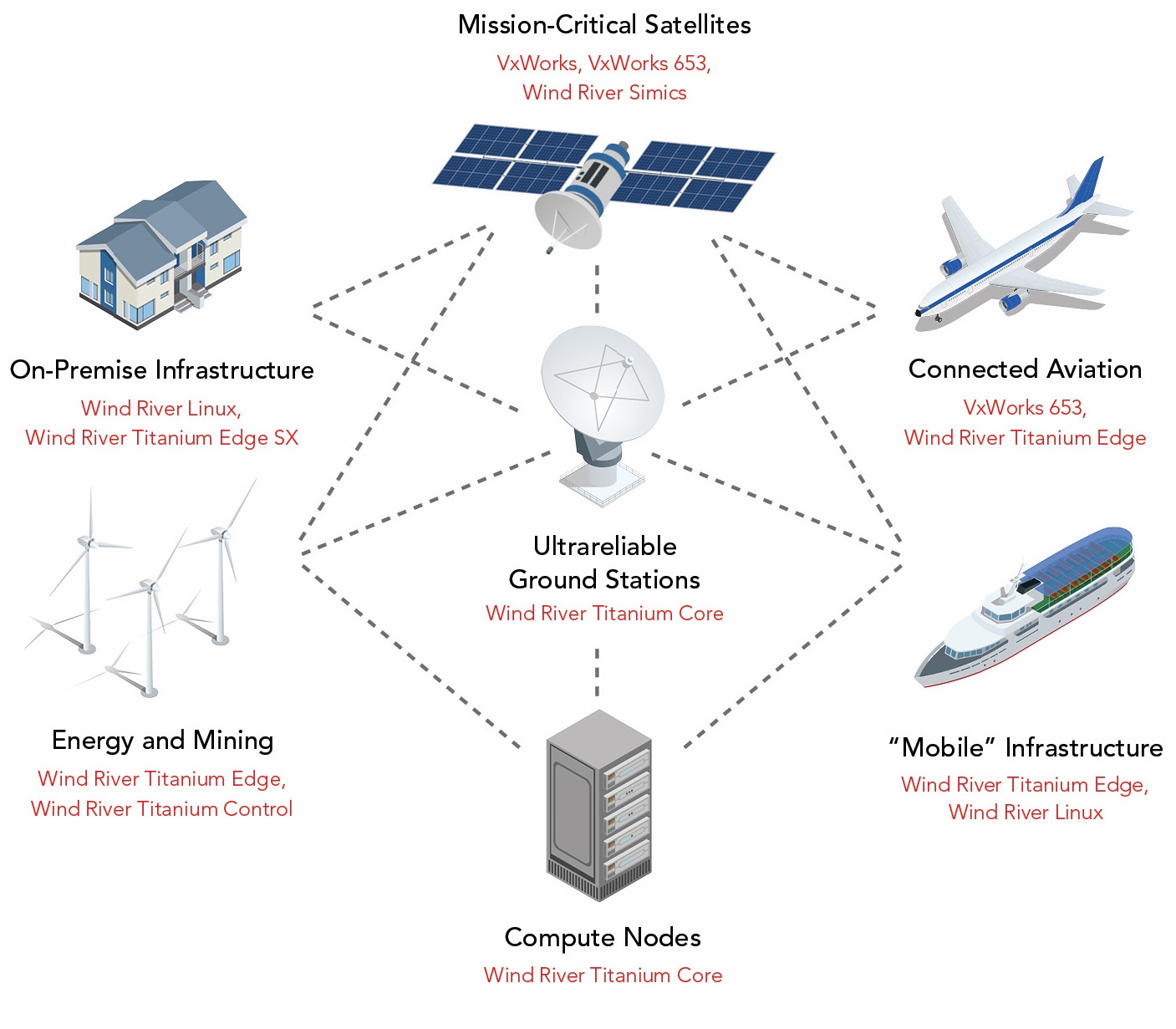Solutions For Space Systems
Enabling the Final Frontier
THE SOLUTION
For more than 20 years, Wind River® has provided solutions that have taken dozens of unmanned systems to space, playing a critical role in some of the most significant space missions in history. A combination of our heritage embedded capabilities and the latest software-defined architecture (SDA) technology is enabling space system providers today with end-to-end software solutions that usher in a new era of flexibility.
Wind River delivers a comprehensive set of solutions from ground station to payload that enable space systems to securely accelerate their development and apply cutting-edge digital transformation paradigms. The following solutions can be integrated into individual components or combined into a comprehensive space systems solution:
- Wind River Titanium Cloud
- VxWorks®
- Wind River Linux
- Wind River Simics®
Discover how these Wind River solutions can support an innovative space systems solution.

VxWorks
VxWorks is the world’s most widely deployed real-time operating system, powering some 2 billion devices including the Mars rover, James Webb Telescope, and NASA Juno. It delivers unrivaled deterministic performance and sets the standard for a scalable, future- proof, safe, and secure operating environment for connected devices in IIoT.
Key features include:
- A proven real-time operating system: VxWorks is proven in mission-critical applications, where security is paramount.
- Security: Best-in-class, pre-integrated security functionality throughout the VxWorks product line includes foundational security capabilities for devices by enhancing device, communication, and management security.
- Multi-core and integrated virtualization capabilities: Virtualization Profile for VxWorks integrates a real-time embedded, Type 1 hypervisor with support for virtual machines into the VxWorks core for consolidation of standalone hardware onto a single multi-core platform. With virtual machines, you can consolidate your core safety-certified and non-safe code on a single VxWorks real-time hosting platform.
Wind River Linux
The embedded operating system of choice for device software developers who want a combination of open source flexibility and commercial-grade reliability and support, Wind River Linux provides improved out-of-box experience with optimized cross-architecture runtime. Wind River Linux security builds on the robust development and commercialization processes that make Wind River the world’s leading embedded Linux OS.
Key features include:
- Yocto Project: Wind River Linux is a Yocto Project Compatible open source baseline and one of the project’s largest contributors of technology. Developers can leverage the flexibility of an optimized open source platform without compromising security.
- ISO 9001 certification: Wind River Linux development and maintenance processes have been certified to the ISO 9001:2015 quality management system standard.
- Security features: Wind River Linux provides an extensive list of security features that help secure access, functions, and data.
- Security support services: Wind River Linux provides ongoing threat mitigation in deployed systems against common vulnerabilities and exposures (CVEs).
Wind River Titanium Cloud
The Titanium Cloud™ portfolio includes the industry’s only fully integrated, ultra-reliable, and deployment-ready virtualization platforms that enable satellite communications providers to deploy virtualized services faster, at lower cost, and with guaranteed uptime.
The product is supported by the Wind River Titanium Cloud Ecosystem, a program that includes validation of interoperability with our hardware and software partners, ensuring optimization of our combined solution.
When service uptime is critical for profitability, Titanium Cloud products ensure that virtualized services run when, where, and how they need to, always.
By virtually any measure, Titanium Cloud delivers the results you demand:
- Maintain ultra-reliable communications services: Titanium Cloud ensures that uptime service-level agreements can be met as required by communications applications. This is achieved with carrier grade reliability and performance not available with enterprise class solutions.
- Reduce costs: Titanium Cloud lowers the cost of deployment, operations, and maintenance compared to legacy systems and equipment and further reduces costs by allowing the efficient use of standard, off-the-shelf servers.
- Ensure security: An extensive, built-in, fully integrated and multi-layered security framework protects your systems against network-borne threats.
- Avoid vendor lock-in for hardware and software: Titanium Cloud is based on open source components with 100% open APIs. It is further validated with a rich ecosystem of hardware, management software, and virtual network function providers to ensure interoperability. We apply a three-layer decoupling (application, middleware, hardware) model, enabling our customers to perform rapid replacement of components and reducing the risk of vendor lock-in.
Wind River Simics
Enable developers, test engineers, and operations engineers to simulate anything from chip to system. Simics provides the collaboration, test automation, and availability required for agile development and cost-effective support and maintenance through long product lifecycles.
Key features include:
- Access: Speed time-to-market by providing all teams with access to a virtual hardware environment, free of the constraints of physical hardware.
- Automation: Use the scripting, programmability, and fault injection of Simics to automate and parallelize testing, including options not available on hardware.
- Collaboration: Easily copy and communicate the entire system, including current state and execution history, to anyone on the team, anywhere in the world.
CONCLUSION
The Wind River suite provides software products enabling solutions from payload to ground station, including industry-leading operating systems connecting to an ultra-reliable, on-premise network virtualization platform that can be simulated using powerful hardware simulation tools.
With more than 20 years of experience in space, Wind River is well versed in the exacting, real-time requirements of satellite and ground system solutions. Today, we are enabling the next generation of software virtualization and simulation technologies to drive the transformation of space systems.